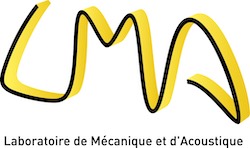Encadrement
- Directeur : Cédric Maury
- Organisme rémunérant : China Scholarship Council
Jury
- François GAUTIER, Professeur, ENSIM, LAUM, Rapporteur
- Philippe HERZOG, Directeur de Recherche CNRS, LMA, Examinateur
- Ulf KRISTIANSEN, Professeur, NTNU, Norvège, Rapporteur
- Cédric MAURY, Professeur, ECM, Directeur de Thèse
- Alexander Mattioli PASQUAL, Professeur Associé, UFMG, Brésil, Examinateur
Résumé
Sensing and controlling the Near-Field Acoustic Radiation Modes (NFARMs) of vibrating structures is of great interest for actively reducing the sound power radiated by such sources from a reduced number of near-field sensors or actuators. The Acoustic Radiation Modes (ARMs) are velocity distributions defined over a vibrating surface, that independently and optimally contribute to the radiated acoustic power over an observation domain. The NFARMs are associated to a near-field observation zone which often surrounds the passengers of car or aircraft at low frequencies. The NFARMs are studied with two improved numerical methods, the Pressure-Velocity (PV) method and the Pressure-Based (PB) method, which rely on the singular values decomposition of the acoustic transfers between the vibrating source and a conformal observation surface. Regular and irregular meshes have been accounted for through volumetric source distributions within the PV and PB methods and convergence criteria have been delineated. Simulations have predicted the NFARMs of a 2D baffled beam, of a 3D baffled plate radiating in free-field or in an enclosure, of a pulsating sphere, of a baffled spherical cap and of a finite baffled cylinder. Differences have been analysed between the NFARMs and the classical Far-Field ARMs and how the NFARMs are modified when the structure radiates in a rigid-walled or in an absorbing cavity. Using the PV formulation, the active and reactive parts of the NFARMs could be separated, and their relative contributions to the complex sound power analysed when varying the source-field observation distance, the frequency of analysis, the source aspect ratio as well as the curvature of the source surface. The NFARMs of a baffled spherical cap, calculated by the PV method, were assessed against those obtained experimentally in the LMA hemi-anechoic room using the reciprocity principle.


